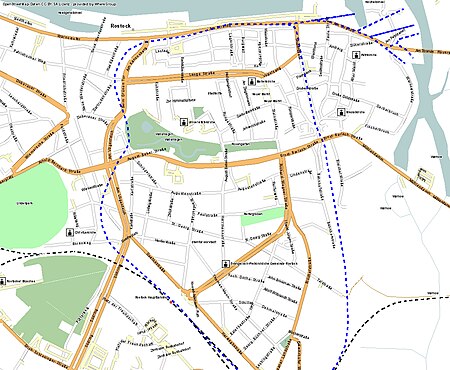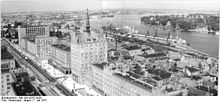Rostock port railway
| Rostock port railway | |
|---|---|
| Gauge : | 1435 mm ( standard gauge ) |
The port railway in Rostock used to be two routes to the port of Rostock on the northern edge of the city center on the Unterwarnow . One line from Friedrich-Franz-Bahnhof , later Rostock freight yard, was in operation from 1853 to the end of the 1990s. A second route, originally called Rostock Strandbahn , ran from the main train station west of the city center to the port. It was in operation from 1889 to 1936.
history
Rostock received a railway connection in 1850 with the Bad Kleinen – Rostock railway line . The first Rostock train station, the Friedrich-Franz-Bahnhof , was located southeast of the historic city center. From there it was only a few hundred meters through Grubenstrasse to the city harbor. A watercourse, the “pit” that ran along the road, had to be bridged. The connection was inaugurated in 1853, and the tracks in the port were completed a little later.
After the completion of the Lloydbahn to Berlin, a two-kilometer-long siding was created from the Lloydbahnhof, later the main train station, to the western part of the city harbor, which went into operation on January 22, 1889. The line, which was also known as the Rostock Strandbahn, branched off to the north at the western head of the station and ran through the moat on the western edge of the city center. An eight-part barrier system was built at the intersection with St.Georg-Straße, which increasingly proved to be a traffic obstacle. Traffic was stopped in 1936. During the war years, the route was partially filled with rubble. The underpass under Schröderstrasse on the southwest edge of the ramparts has been preserved to this day.
The former Friedrich-Franz-Bahnhof became the Rostock freight yard after passenger traffic ceased in 1905. In 1911 the port railway was expanded and new tracks were laid across the Petri Bridge in the east port.
After the end of the Second World War, the handling performance in the port of Rostock grew, among other things for reparations payments to the Soviet Union. Since the track to the main station was no longer available, an attempt was made in 1949 to build a line to Rostock-Bramow station via the Neptun shipyard to relieve the line to the freight station . After a bridge in the "Am Kabutzenhof" area was unable to cope with the load, this connection was dismantled in 1959.
The Rostock city port was no longer sufficient to meet the requirements of the time of German division. At the beginning of the 1960s, Rostock's overseas port at Breitling outside the city center went into operation. An extension of the port railway to the new port was briefly considered, but was ruled out due to capacity reasons and the overseas port was given its own connecting route . After the overseas port opened, the importance of the city port decreased significantly. Already in the GDR era, consideration was given to discontinuing the port railway, mainly because of the level crossing with the important main street “Am Strande”. However, the railway was only stopped in 1991 after the city port had finally lost its function as a freight transshipment point. As a result, the track was dismantled. The Rostock freight yard also lost its tracks a few years later.
Todays situation
The track systems have been completely dismantled apart from a few individual remains. The mine road between the freight yard and the city port was redesigned after the port railway was shut down. The city harbor itself has also been completely redesigned and is now mainly used for tourism. Remnants of the track can be found above all in the area of the east port on the other side of the Oberwarnow , which was crossed by the track of the port railway on the Petribrücke. A service building has been preserved in the city harbor and is used as a so-called engine shed for occasional events. The Mecklenburg Railway Association also uses the building and has set up some rail vehicles in front of it. The underpass of the line under Schröderstrasse and an adjoining retaining wall have been preserved from the port railway of Lloydbahn. The old route can still be seen in the area of the fishing bastion near the Warnow.
literature
- Lothar Schultz, Klaus Pfafferott, Hans-Georg Tack: The railroad in the Rostock city harbor: A journey through 140 years of railroad and city history , Verlag Bernd Neddermayer 2009, ISBN 3-933-25496-5
- Lothar Schultz, Peter Wilhelm, Klaus Pfafferott: 150 years of the railway in Rostock , transpress 2000, ISBN 3-613-71124-9
- Lothar Schultz: 130 years of the Rostock Railway. German Model Railway Association of the GDR, 1980
- Lothar Schultz, Die Lloydbahn, Neustrelitz – Rostock – Warnemünde , Verlag Bernd Neddermeyer, Berlin 2010, ISBN 978-3-941712-08-9 , pp. 83-87




